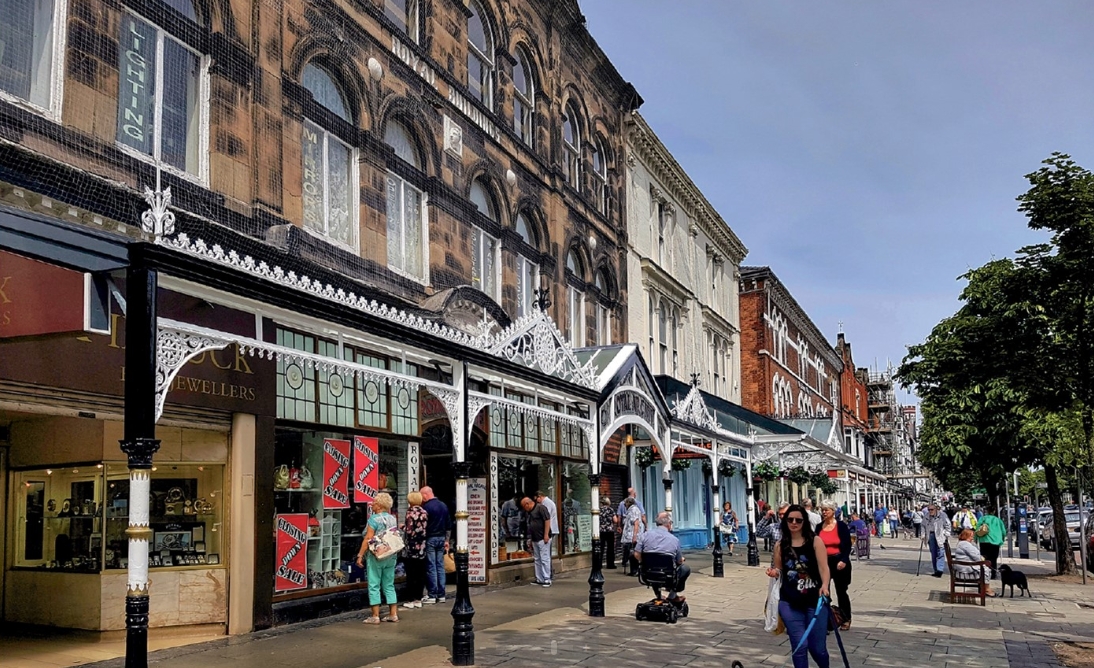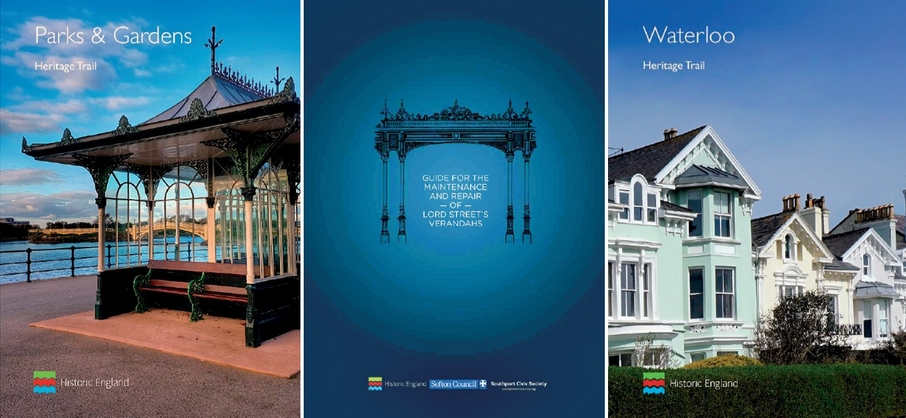What makes a heritage-at-risk officer
This article originally appeared in IHBC’s Context 150, published in July 2017. It was written by Dan Longman, a heritage-at-risk officer at Sefton Council.

|
| Lord Street, Southport, with its distinctive, cast iron verandas, inspired the tree-lined thoroughfares of Paris (Prince Louis- Napoléon Bonaparte, the future Napoléon III, having lodged here in 1846). Some of the verandas have become serious eyesores, while others have been restored. |
Before joining Sefton Council as its new heritage-at-risk officer I had only a vague idea about what the job would entail. ‘Heritage at risk’ is one of those phrases that sounds interesting, but when I explain to people what I do, I am often met with polite but feigned awareness, or blank stares. The position of heritage-at-risk officer is something of a rarity, with only a handful of posts in the entire country.
The job is tricky to pigeonhole, calling for the work of several professionals rolled into one: the cautious outlook of a conservation officer, the dogged tenacity of a detective, and the calm demeanour of a diplomat. These attributes, combined with a little journalistic panache and jester-like juggling, are all needed to get through the day-to-day workload in heritage at risk. The focused nature of the job allows work to be carried out without the many distractions that would otherwise burden a standard conservation or enforcement officer. We can strive towards specific objectives with relative ease.
In the beginning, Historic England’s heritage-at-risk programme was designed to help our understanding of the overall condition of historic sites across the country. Launched in 2008, the scheme identifies those sites that are most at risk of being lost as a result of neglect, decay or inappropriate development. Every year Historic England updates the Heritage-at-Risk Register, providing a dynamic picture of those places most in need of safeguarding for the future.
There are just over 5,000 entries named on the register, with 11 entries under my watch in Sefton. We have two buildings, two places of worship, one scheduled monument and six conservation areas deemed to be worthy of the list. On the face of it that number does not seem large, but the multitude of different properties within those conservation areas does pose problems.
Fortunately, this council takes conservation very seriously, and I am not on my own. I have the support of council members who innovatively approved a subsidy from the Community Support Fund to pay a salary. I work alongside two full-time conservation officers and a small team of enforcement officers who assist me in tackling decay and inappropriate development across the borough. The job involves plenty of site visits, getting out from behind the desk and personally assessing all sorts of buildings out in the field.
One of our most persistent problem areas is Lord Street. This historic boulevard can be found in the seaside town of Southport, once one of the UK’s most popular resorts, famous for holidays and day-trippers. Lord Street is historically significant not only for providing inspiration for the tree-lined thoroughfares of Paris (Prince Louis-Napoléon Bonaparte, the future Napoléon III, lodged just off Lord Street in 1846), but also for its rows of ornate cast-iron verandas which stand decoratively over the shopfronts.
Southport’s corrosion-inducing coastal environment has led to numerous issues with these structures, many of which are listed and date back to the mid-Victorian era. The maintenance and condition of each veranda is ultimately the responsibility of the owner of the premises. Over the years some landlords have neglected to maintain them properly, resulting in blocked gutters, flaking paintwork and other minor matters that have grown to become serious eyesores in this otherwise picturesque location.
Thankfully the law is on our side when it comes to curing these aesthetic ills. Section 215 of the Town and Country Planning Act 1990 allows local planning authorities to take action if the amenity of an area is adversely affected by the condition of land, and demand that steps be taken to remedy the problem. As heritage-at-risk officer I prepare schedules of works, serve enforcement notices on irresponsible owners and request that works be completed within a specified timescale. Failure to do so will result in our enforcement team taking over, and sometimes owners being hauled before the magistrates’ court to face financial penalties as a last resort.
To help avoid this I have recently prepared a brief maintenance guide to assist owners in looking after their verandas. This should help bring about a reduction in basic problems and prevent minor matters escalating into significant structural defects. Over time the look of Southport has steadily improved, and these important listed structures have been restored to their former glory for the enjoyment of future generations. Heritage at risk is as much about prevention as it is about cure.

|
| The council has prepared a maintenance guide on verandas, and it has collaborated with community groups to create heritage trails for Southport’s parks and gardens, the Regency town of Waterloo, and Lord Street. |
The job throws up all sorts of issues, some quite substantial, such as the maintenance of an abandoned listed school in dire need of regeneration, to more common concerns such as inappropriate signage, unauthorised uPVC windows, peeling paintwork and planning violations.
Parts of the job will be familiar to most local authorities. Working with colleagues in the preparation of conservation area appraisals and management plans has been particularly important. Appraisals allow the council to judge planning applications in the light of the significance of heritage assets highlighted in our reports. Due to past pressures, it is only now with the support of this role that much of this analysis is finally being carried out. Councils up and down the country are facing increasing workloads with fewer resources, so it is vital that temporary posts such as this help plug the gap until a long-term solution can be found.
Other major elements of the work of a heritage-at-risk officer are publicity, promotion and even inspiration. Earlier this year we collaborated with several community groups to produce a trio of heritage trails aimed at showcasing the history of Lord Street, Southport’s parks and gardens, and the Regency town of Waterloo. The Titanic’s Captain Smith once lived just a few yards up the road from the childhood home of Joseph Bruce Ismay, the managing director of the White Star Line. Everton FC’s ground owes much of its past to Waterloo-based engineer George Goodison.
Back in the office I regularly update fellow employees across the whole council using our internal media network, raising the profile of the conservation team and publicising the efforts we make to enhance the historic environment. We hope these actions are inspiring people to pay more attention to their local heritage and instilling a lost sense of civic pride.
Heritage-at-risk officers are basically personified reactions to a lack of care in the historic environment. My next task is to look further afield and target other buildings that are dragging conservation areas down into the murky realms of ‘at risk.
This article originally appeared in IHBC’s Context 150, published in July 2017. It was written by Dan Longman, a heritage-at-risk officer at Sefton Council.
--Institute of Historic Building Conservation
Related articles on Designing Buildings Wiki
- Conservation officer.
- Heritage Action Zone.
- Heritage Asset.
- Heritage at Risk Register.
- Heritage at risk register 2020.
- Heritage Cases on Enforcement Registers in England.
- Heritage definition.
- Heritage partnership agreements HPA.
- Historic England.
- IHBC articles.
- Nominating heritage assets.
- The benefits of investing in heritage at risk.
- The Institute of Historic Building Conservation.
IHBC NewsBlog
Old Sarum fire in listed (& disputed) WW1 Hangar - Wiltshire Council has sought legal advice after fire engulfed a listed First World War hangar that was embroiled in a lengthy planning dispute.
UK Antarctic Heritage Trust launches ‘Virtual Visit’ website area
The Trust calls on people to 'Immerse yourself in our heritage – Making Antarctica Accessible'
Southend Council pledge to force Kursaal owners to maintain building
The Council has pledged to use ‘every tool in the toolbox’ if urgent repairs are not carried out.
HE’s Research Magazine publishes a major study of the heritage of England’s suburbs
The article traces the long evolution of an internal programme to research 200 years of suburban growth
IHBC Context 183 Wellbeing and Heritage published
The issue explores issues at the intersection of heritage and wellbeing.
SAVE celebrates 50 years of campaigning 1975-2025
SAVE Britain’s Heritage has announced events across the country to celebrate bringing new life to remarkable buildings.
IHBC Annual School 2025 - Shrewsbury 12-14 June
Themed Heritage in Context – Value: Plan: Change, join in-person or online.
200th Anniversary Celebration of the Modern Railway Planned
The Stockton & Darlington Railway opened on September 27, 1825.
Competence Framework Launched for Sustainability in the Built Environment
The Construction Industry Council (CIC) and the Edge have jointly published the framework.
Historic England Launches Wellbeing Strategy for Heritage
Whether through visiting, volunteering, learning or creative practice, engaging with heritage can strengthen confidence, resilience, hope and social connections.














